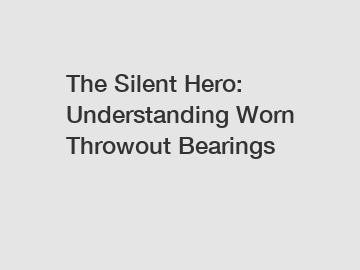The Silent Hero: Understanding Worn Throwout Bearings
Google Hot Topics: The Silent Hero: Understanding Worn Throwout Bearings?
Have you ever heard of throwout bearings? These small but essential components play a crucial role in the operation of manual transmissions. While they may not be subjects of daily conversation, understanding worn throwout bearings can save you from potential headaches down the road. In this article, we will delve into the workings of throwout bearings, their common signs of wear, the consequences of neglecting them, and the necessary maintenance to keep them in top shape.
1. What exactly is a throwout bearing?

A throwout bearing, also known as a clutch release bearing, is a mechanical component located inside the bellhousing of a manual transmission. It acts as a link between the clutch fork and the pressure plate, ensuring smooth and effortless engagement and disengagement of the clutch. When you press the clutch pedal, the throwout bearing applies pressure to the diaphragm spring, releasing the clutch disc from the flywheel.
2. Signs of a worn throwout bearing.
An important aspect of prolonging the lifespan of your clutch system is being able to identify signs of worn-out throwout bearings. One of the most common signs is a high-pitched squealing noise that occurs when you depress the clutch pedal. This noise can indicate a lack of lubrication within the bearing or worn-out components. Another symptom is a grinding or rattling sound when the clutch is engaged or disengaged.
3. The consequences of neglected throwout bearings.
Ignoring the signs of worn throwout bearings can have serious consequences for your vehicle. If the bearing completely fails, your clutch may become inoperable, leaving you stranded. Additionally, a damaged or worn throwout bearing can cause damage to other clutch components, such as the pressure plate and clutch disc. This can lead to costlier repairs and potentially necessitate a complete clutch system replacement, which is both labor-intensive and expensive.
4. Maintenance to keep throwout bearings in top shape.
To avoid premature wear and tear of throwout bearings, regular maintenance is essential. Ensure the clutch system is properly adjusted, allowing for smooth operation of the bearing. Pay attention to any unusual noises or vibrations and have them inspected promptly. Lubricating the bearing regularly, as per manufacturer guidelines, helps prevent excessive friction and premature wear. Regular clutch inspections by a qualified mechanic can catch any potential issues before they cause major damage.
In conclusion, understanding worn throwout bearings is crucial for the smooth operation and prolonged lifespan of your manual transmission system. Recognizing the signs of wear, such as squealing or grinding noises, is the first step in preventing further damage to the clutch components. By promptly addressing any issues and ensuring regular maintenance, you can save yourself from costly repairs and unexpected breakdowns.
Remember, the silent hero is not immune to wear and tear. Stay vigilant and keep your throwout bearings in check for a hassle-free driving experience with your manual transmission vehicle.
For more information, please visit shaft cross, function of release bearing, function of release bearing.

Comments
0